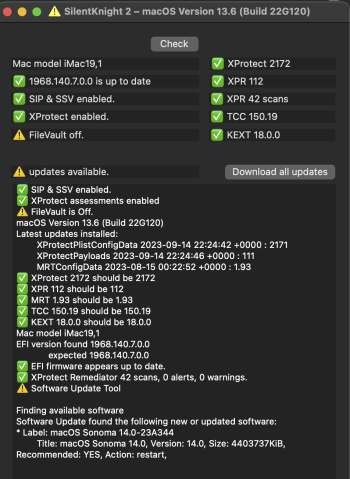Blade upgrade by @MacNB2
Device: Late 2013 - 14,2 - ME089LL (3.4Ghz i5-4670, 1TB HDD, No Blade).
Blade added: 1TB Kioxia EXCERIA G2 PCIe/NVMe 1.3 Gen3x4
HDD upgrade: 1TB SATA HDD -> -/-
BootROM version: 433.140.2.0.0
SMC Version: 2.15f7
Speed test: ~660 MB/s read, ~770 MB/s write
OS: Catalina 10.15.7
Adapter: eBay
Heatsink: eBay
Temperature sensor: not used - not needed for NVMe
Issues after Cloning HDD->SSD: NONE, no sleep or hibernate issues
This iMac model did not include an Apple blade so the socket was empty.
Kept the existing HDD spinner as a backup drive (that's also bootable).
All has been working fine for last six months.
Until a couple of week ago....while using it the iMac,
the screen just went black and rebooted into the HDD (not the SSD).
This booted fine. But could not see the NVMe SSD in Finder nor Disk Utility...the NVMe SSD just disappeared

Shutdown.
Pulled the Power plug and waited 1 minute. Pressed the Power Button for 30 sec to ensure no residue power.
Plugged Power cable in and waited 30 secs.
Powered up and kept
Alt+CMD+P+R for three bongs and released to reset NVRAM.
Pressed
Alt key to see the Apple Startup disk picker....but
only the HDD spinner listed

Restarted and held the
D key on the keyboard to start the internet diagnostics.
Diagnostics found no errors (code AD000).
Restarted and held
Alt key to see the Apple Startup picker....hey presto NMVe SSD
and HDD listed.
Booted from NVMe fine and thought ...problem solved without knowing what was the problem.
Ran DriveDX App and there are absolutely no issues flagged with the NVMe after 700 hours ON time and ~300 power Ups. Max Temp never exceeded 48 Deg C.
Has been running fine for two weeks....till today...same problem...
the screen just went black and rebooted into the HDD (not the NVMe SSD). Arrrrrgh.
Tried everything I did before to make the NMVe "visible" but now not seen at all. IOREG shows no PCIe NVMe Device.
What can cause this ? NVMe or Logicboard failure or both ?
Tempted to dismantle it all and replace the NVMe with a new one but it could be the Logicboard ?
UPDATE:
Had no choice but to dismantle the whole iMac again

First I checked if the NMVe had come off the mount (causing the issue) but it was seemed screwed in perfectly :
On removing the Logic board, I noticed that I had inserted the NVMe+Adapter into the connector "too" deep such that some of the pins on the Adapter appear to be shorting with the Logic board connector shield

:
OOOPS !
Did a bit of search (something I should done before the installation) and came across
post here that thoroughly documented how to add an NVMe and pitfalls to be aware of.
Basically, I had to cover the exposed pins with Kapton tape to stop them from touching the connector shield:
The NVMe was "seen" and able to boot but it appears the OS or something was corrupted (presumably when it suddenly stopped working). Many Apps would not open and the beachball ruled. Cloning the working HDD to the NVMe solved that issue.
So fingers crossed that this shorting was the only issue and not the NVMe or the Logic board 🤞



